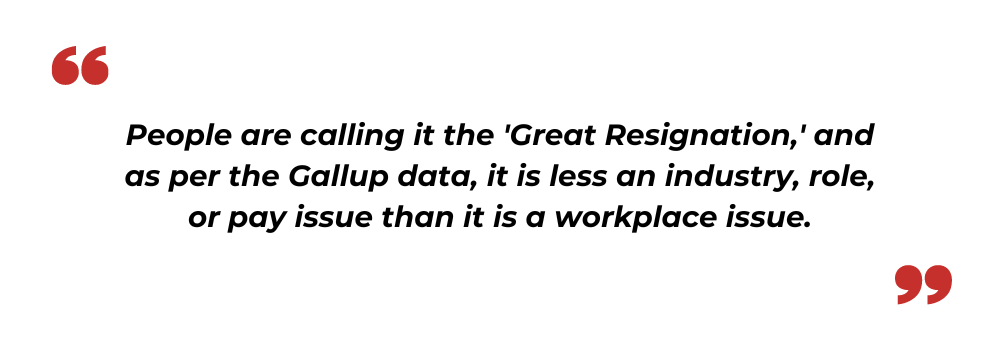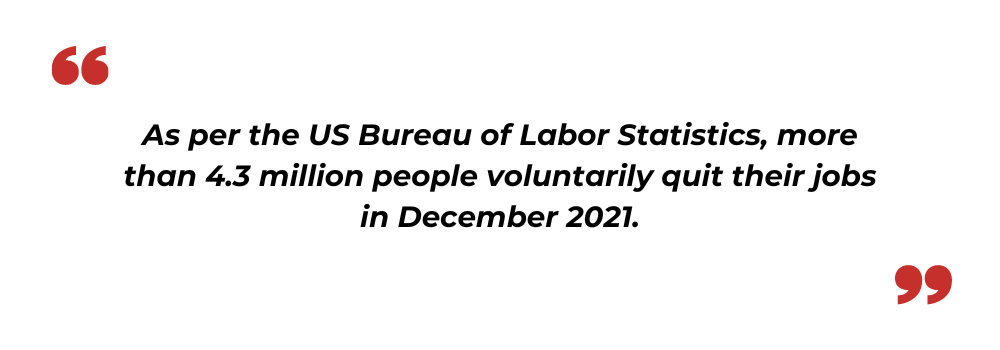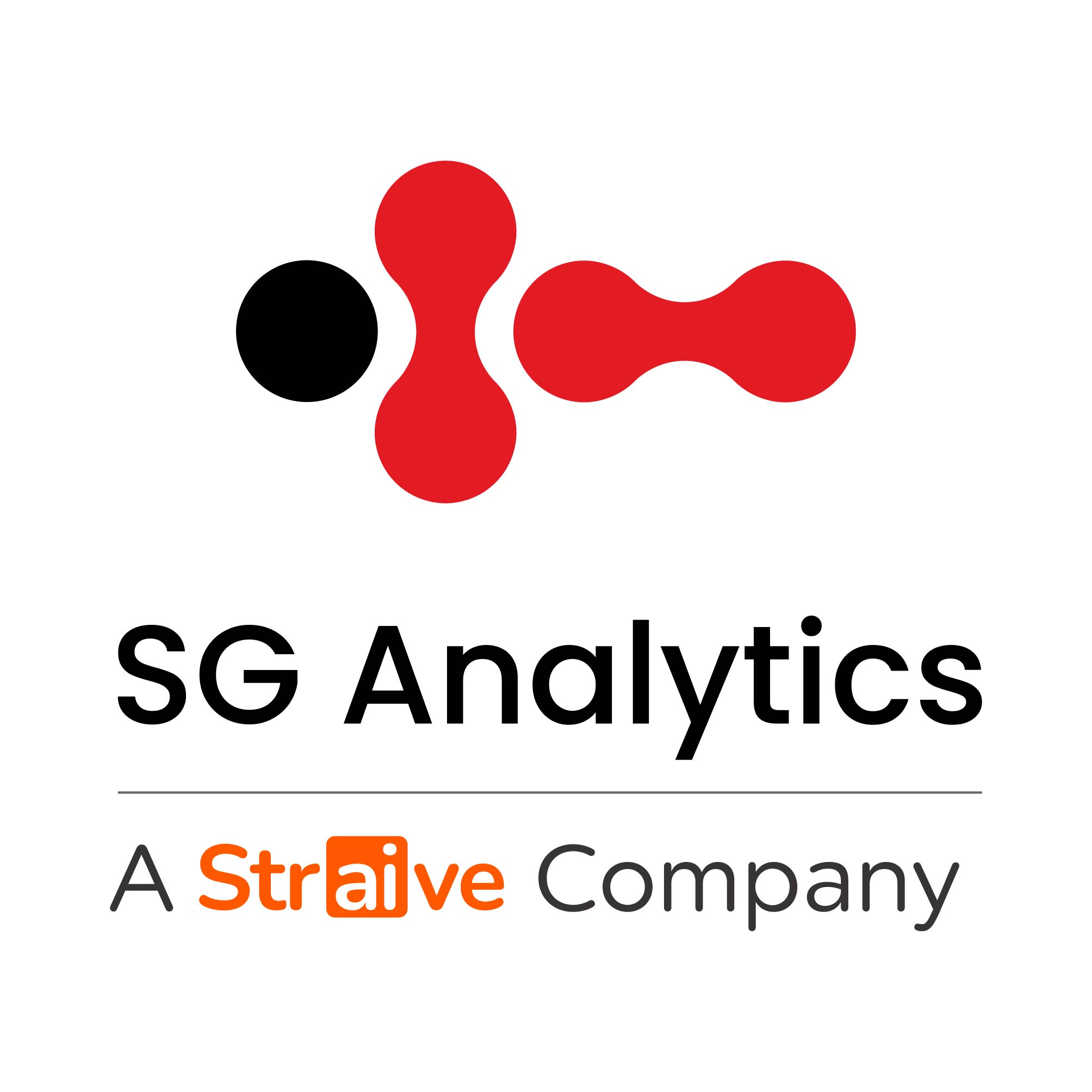In the past, spikes in voluntary attrition have often signaled the rising competition for talent, where in-demand workers left their job for a similar but better one. However, the recent wave of attrition is significantly different. Most of the employees are leaving their existing jobs to take on very different roles or to just leave the workforce entirely.
Quitting: The Trend in Vogue
The U.S. unemployment saw a record low, but with 11.3 million open jobs. However, it is easy to understand this optimism. This high demand is driving more than half of those who quit to not only move into a new job but also into a new industry. However, only 6% of employees are making a lateral move within their industry. The public and social sectors always have had the greatest attrition rate, with 57% leaving the sector. The healthcare and pharma sectors are considered to have had the least.
Workers are leaving their workplaces faster than they can be replaced. As per the report issued by the U.S. Bureau of Labor Statistics, more than 4.3 million people voluntarily resigned from their jobs in December 2021. The reported number was slightly below the record high in November 2021. However, in October 2021, 4.2 million Americans quit their jobs, a trend mirrored by the Organization for Economic Co-operation and Development (OECD).

Read more: Anticipating the Unanticipated: Balancing Business Resilience in the new age of Innovation
What significantly matters is that many are not willing to return to their former industries or the job world anytime soon. Of those who are quitting without a new job in hand, only 47% are showing interest in returning to the workforce, and 29% are returning to traditional full-time employment. However, some companies are still waiting for these people to come back, and they are willing to wait as well.
But where did they go?
Many claimed this to be the beginning of the ‘Great Resignation’ – an exodus of disenfranchised workers who were fed up with their corporate life. However, the reported facts have a different story to tell- employee engagement is at an all-time high, whereas unemployment is at an all-time low.

The Great Resignation: Facts in Context
- The rate of employees quitting hit a record in late 2021 and has remained high ever since. The quits data is skewed by the rate of employees quitting in the Accommodation and Food Service sectors. These industries have experienced twice the average quits in comparison to other professions.
- Workers are leaving for new jobs and not the workforce. They are only resigning with a new opportunity in hand.
- The ratio of employment seekers to open jobs has never been this low since the 1960s. There are roughly two vacant jobs for every job seeker. Usually, there are several job seekers for every vacancy.
- Workers are not resigning. Engagement is nearing an all-time high. The average engagement data shows significant variations in employee experience. However, what matters more is the workforce engagement along with the effects of policies on different cohorts.
Read more: A New Approach to Accelerate Innovation in Market Research
Factors Driving the Great Resignation
With the pandemic forcing virtual working for all, many workers decided they preferred the new normal setup. Many surveys have reported that workers were pumped by this new flexibility. There was a wider realization that office environments and work culture were designed with an idealized worker in mind and not around diversity for workers’ needs. However, this one size fits all design could only serve a very few.

And knowledge workers are increasingly able to work from anywhere in the country. This flexibility empowers them to pursue their dream jobs to offer a purpose and not the paycheck. This hyper-mobility of the new working model is helping employers to broaden their talent horizons, as companies are now more open to recruiting new talent to the workplace.
Workers have increased their agency and autonomy as they are waking up to new possibilities. This leads to opening new doors to new questions leading to a great re-evaluation of priorities.
What kind of business are the employees willing to work for?
What, beyond money, are they exploring the most?

However, this is being perceived as good news for many organizations that can:
- Maintain as well as draw from a much wider talent pool
- Reduce the cost of facilities
- Retain existing talent for the right reasons, including powerful and compelling purpose, culture, or ethos
- Place employee experience at the center of the brand table
Laggards in managing talent and culture is a major struggle for many organizations. However, the new hypermobility is shining a bright light on companies whose employee experience is subpar. Firms that insist on pre-pandemic policies are likely to face a talent exodus and miss opportunities to recruit from a wider talent pool.

For businesses that are prioritizing employee experience, the Great Resignation will likely prove to be a great opportunity for them.
Read more: Data-Centricity: The New Roadmap to Driving Enterprises in a Changing World
The Five Employees Personas that are Driving the Great Resignation
With mass resignations taking place, employers are exploring and recognizing which types of employees are open to new jobs—and what it will take to hire as well as retain them. As per a recent study, McKinsey identified five employee personas that may be driving the ‘Great Resignation.’ They are-

- Traditionalists — Traditionalists are career-oriented workers who are willing to make trade-offs if given the right outlay. They are less likely to quit without another job offer in hand and more likely to stay if they feel valued as well as get enough money.
- The do-it-yourselfers — Appear as the largest cohort in the study. They are a group of workers that tends to put more value on flexibility, meaningful work, and compensation. They can typically be self-employed or do gig work/ part-time jobs. They look mostly for flexibility and friendly work culture.
- The caregivers — These are the ones who feel at home but also want more. Typically, between the 18 to 44 years of age group, with the possibility of more women, the caregiver personas decided to sit it out at home and are now looking to explore roles with flexibility that also allow them to continue their caregiving and responsibilities exceeding their jobs.
- The idealists — Usually, a younger cohort of students and younger part-timers, between 18 to 24, are more inclined towards flexibility, strong organizational culture, and clear career advancement trajectories. They belong to an inclusive and welcoming community.
- The relaxers — These individuals are a mix of retirees who are not looking for work, while some might show a willingness to return to traditional work if the job is the right fit for them. They crave meaningful work and balance. Organizations are experiencing a rise in the number of retired workers returning to work following a sudden surge in retirement due to the onset of the pandemic.
Read more: Blockchain Gamification and the Emergence of Innovative Business Models
To Sum Up
The sudden departures have left a huge hole in the labor market. The Great Resignation is putting the limelight on leaders who lack in creating flexible and meaningful work environments. Rather a holistic and mindful approach will allow businesses to attract and retain talented workers who can deeply connect with the company vision.
Attributing the record-high quit rate to pay issues bypasses the bigger picture of the workplace. The pandemic has completely altered the way people work and how they perceive work. While many are reflecting on what a quality job feels like, others are taking it a step ahead and willing to quit to find one that fits their expectations.
Companies are now exploring opportunities to maximize their pay strategies by calibrating an effective rewards program along with an understanding of how all the program’s components are expected to affect various employee perceptions, behaviors, and outcomes. To address this attrition-attraction issue, companies are doubling down on their value propositions for both traditional, which incorporates pay, title, benefits, and career paths, and nontraditional, which concerns flexibility, company culture as well as personalization.
Reversing this tide in an organization will require leaders who care, engage, and provide employees with a sense of purpose, inspiration, and motivation.
Reversing the Great Resignation first requires fixing the Great Discontent; only then will other components fall in place.
With a presence in New York, San Francisco, Austin, Seattle, Toronto, London, Zurich, Pune, Bengaluru, and Hyderabad, SG Analytics, a pioneer in Research and Analytics, offers tailor-made services to enterprises worldwide.
A leader in Market Research services, SG Analytics enables organizations to achieve actionable insights into products, technology, customers, competition, and the marketplace to make insight-driven decisions. Contact us today if you are an enterprise looking to make critical data-driven decisions to prompt accelerated growth and breakthrough performance.

